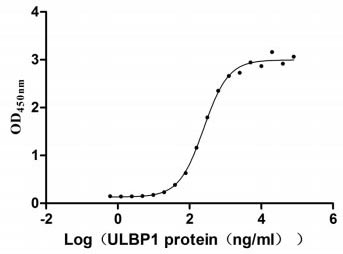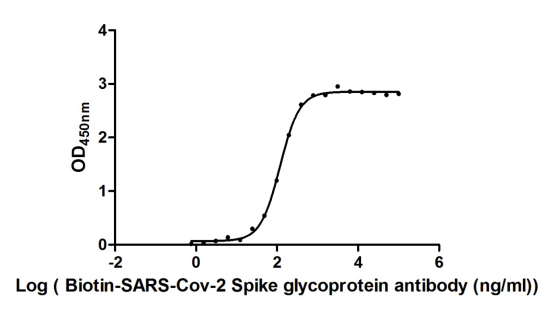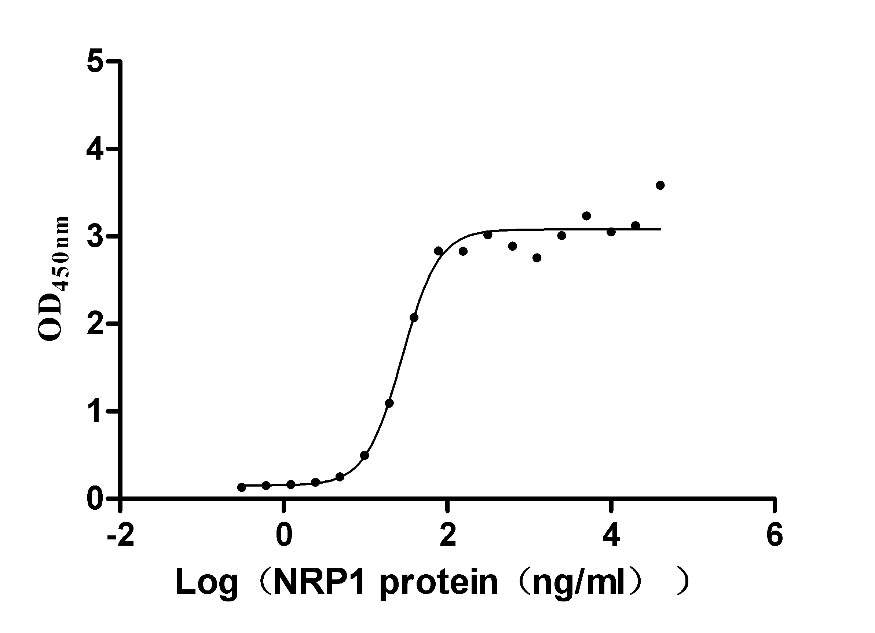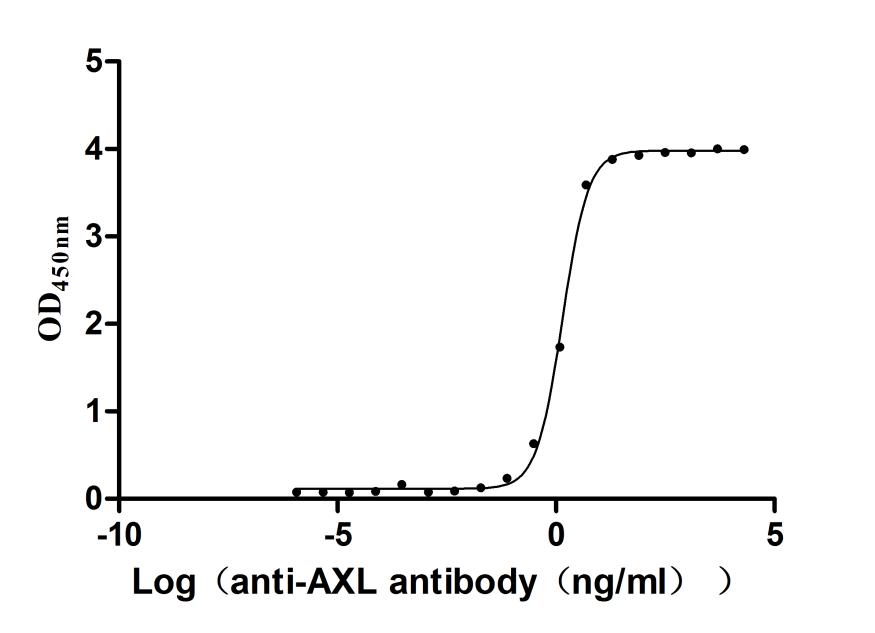Recombinant Mouse Krueppel-like factor 3 (Klf3)
-
货号:CSB-YP723361MO
-
规格:
-
来源:Yeast
-
其他:
-
货号:CSB-EP723361MO
-
规格:
-
来源:E.coli
-
其他:
-
货号:CSB-EP723361MO-B
-
规格:
-
来源:E.coli
-
共轭:Avi-tag Biotinylated
E. coli biotin ligase (BirA) is highly specific in covalently attaching biotin to the 15 amino acid AviTag peptide. This recombinant protein was biotinylated in vivo by AviTag-BirA technology, which method is BriA catalyzes amide linkage between the biotin and the specific lysine of the AviTag.
-
其他:
-
货号:CSB-BP723361MO
-
规格:
-
来源:Baculovirus
-
其他:
-
货号:CSB-MP723361MO
-
规格:
-
来源:Mammalian cell
-
其他:
产品详情
-
纯度:>85% (SDS-PAGE)
-
基因名:Klf3
-
Uniprot No.:
-
别名:Klf3; Bklf; Krueppel-like factor 3; Basic krueppel-like factor; CACCC-box-binding protein BKLF; TEF-2
-
种属:Mus musculus (Mouse)
-
蛋白长度:full length protein
-
表达区域:1-344
-
氨基酸序列MLMFDPVPVK QEAMDPVSVS FPSNYIESMK PNKYGVIYST PLPDKFFQTP EGLTHGIQVE PVDLTVNKRG SPPAAGGSPS SLKFPSHRRA SPGLSMPSSS PPIKKYSPPS PGVQPFGVPL SMPPVMAAAL SRHGIRSPGI LPVIQPVVVQ PVPFMYTSHL QQPLMVSLSE EMDNSNSGMP VPVIESYEKP LLQKKIKIEP GIEPQRTDYY PEEMSPPLMN PVSPPQALLQ ENHPSVIVQP GKRPLPVESP DTQRKRRIHR CDYDGCNKVY TKSSHLKAHR RTHTGEKPYK CTWEGCTWKF ARSDELTRHF RKHTGIKPFQ CPDCDRSFSR SDHLALHRKR HMLV
-
蛋白标签:Tag type will be determined during the manufacturing process.
The tag type will be determined during production process. If you have specified tag type, please tell us and we will develop the specified tag preferentially. -
产品提供形式:Lyophilized powder
Note: We will preferentially ship the format that we have in stock, however, if you have any special requirement for the format, please remark your requirement when placing the order, we will prepare according to your demand. -
复溶:We recommend that this vial be briefly centrifuged prior to opening to bring the contents to the bottom. Please reconstitute protein in deionized sterile water to a concentration of 0.1-1.0 mg/mL.We recommend to add 5-50% of glycerol (final concentration) and aliquot for long-term storage at -20℃/-80℃. Our default final concentration of glycerol is 50%. Customers could use it as reference.
-
储存条件:Store at -20°C/-80°C upon receipt, aliquoting is necessary for mutiple use. Avoid repeated freeze-thaw cycles.
-
保质期:The shelf life is related to many factors, storage state, buffer ingredients, storage temperature and the stability of the protein itself.
Generally, the shelf life of liquid form is 6 months at -20°C/-80°C. The shelf life of lyophilized form is 12 months at -20°C/-80°C. -
货期:Delivery time may differ from different purchasing way or location, please kindly consult your local distributors for specific delivery time.Note: All of our proteins are default shipped with normal blue ice packs, if you request to ship with dry ice, please communicate with us in advance and extra fees will be charged.
-
注意事项:Repeated freezing and thawing is not recommended. Store working aliquots at 4°C for up to one week.
-
Datasheet :Please contact us to get it.
靶点详情
-
功能:Binds to the CACCC box of erythroid cell-expressed genes. May play a role in hematopoiesis.
-
基因功能参考文献:
- mechanistic insights into the regulation of Lgals3, demonstrating that C-terminal binding protein (CtBP) is required to drive optimal KLF3-mediated silencing. PMID: 27226561
- Phosphorylation of KLF3 and CtBP2 by HIPK2 strengthens the interaction between these two factors and increases transcriptional repression by KLF3. PMID: 25659434
- We conclude that KLF3 plays diverse and important roles in cardiovascular development and function in mice. PMID: 23874215
- KLF3 binds the Fam132a promoter in vitro and in vivo and that this leads to repression of promoter activity. Fam132a is significantly upregulated in the absence of KLF3. PMID: 23633521
- KLF3 and KLF8 have overlapping roles in vivo and participate in the silencing of embryonic globin expression during development. PMID: 23716600
- we concluded that KLF3 is a transcriptional repressor for wee1 gene. PMID: 22115574
- KLF3 is a driving force toward marginal zone B-cell maturation. PMID: 21297003
- KLF3 is an important regulator of several biological processes, including adipogenesis, erythropoiesis, and B cell development. (Review) PMID: 21360637
- role for KLF3 in muscle gene regulation and an alternate mechanism for transcriptional regulation by SRF via its recruitment to KLF binding sites PMID: 20404088
- Proviral integration of an Abelson-murine leukemia virus deregulates BKLF-expression in the hypermutating pre-B cell line 18-81. PMID: 15829312
- basic Kruppel-like factor gene (Klf3) has a role with CtBP in adipogenesis PMID: 18391014
显示更多
收起更多
-
亚细胞定位:Nucleus.
-
蛋白家族:Krueppel C2H2-type zinc-finger protein family
-
组织特异性:In 8.5 day embryos, expressed in midbrain, anterior hindbrain and ventral forebrain. In 9 day embryos, expressed throughout ventral anterior half of embryo including midbrain-hindbrain junction, ventral midbrain, diencephalon and forebrain. At 10.5 days,
-
数据库链接:
KEGG: mmu:16599
STRING: 10090.ENSMUSP00000128429
UniGene: Mm.392759
Most popular with customers
-
Recombinant Human NKG2-D type II integral membrane protein (KLRK1), partial (Active)
Express system: Mammalian cell
Species: Homo sapiens (Human)
-
Recombinant Severe acute respiratory syndrome coronavirus 2 Spike glycoprotein (S), partial (Active)
Express system: Mammalian cell
Species: Severe acute respiratory syndrome coronavirus 2 (2019-nCoV) (SARS-CoV-2)
-
Recombinant Human Neuropilin-1 (NRP1) (Active)
Express system: Mammalian cell
Species: Homo sapiens (Human)
-
Recombinant Human Cytotoxic and regulatory T-cell molecule (CRTAM), partial (Active)
Express system: Mammalian cell
Species: Homo sapiens (Human)
-
Recombinant Human Interleukin-2 (IL2) (Active)
Express system: Mammalian cell
Species: Homo sapiens (Human)
-
Recombinant Macaca fascicularis C-type lectin domain family 4 member C(CLEC4C), partial (Active)
Express system: Mammalian cell
Species: Macaca fascicularis (Crab-eating macaque) (Cynomolgus monkey)
-
Express system: Mammalian cell
Species: Macaca mulatta (Rhesus macaque)
-
Recombinant Human Tyrosine-protein kinase receptor UFO(AXL),partial (Active)
Express system: Mammalian cell
Species: Homo sapiens (Human)




















